Here at Pepper Geek, growing peppers is our passion. With over 10 years of growing experience under our belts, we have learned how to care for peppers at every stage of growth.
We reviewed hundreds of questions from our readers and YouTube viewers to compile an extensive list of care tips. In this article, we’ll share our top tips for caring for pepper plants at every plant stage.
If we knew these tips when we started growing peppers back in 2013, we would have prevented a lot of headaches (and saved a lot of plants!). Let’s get started.
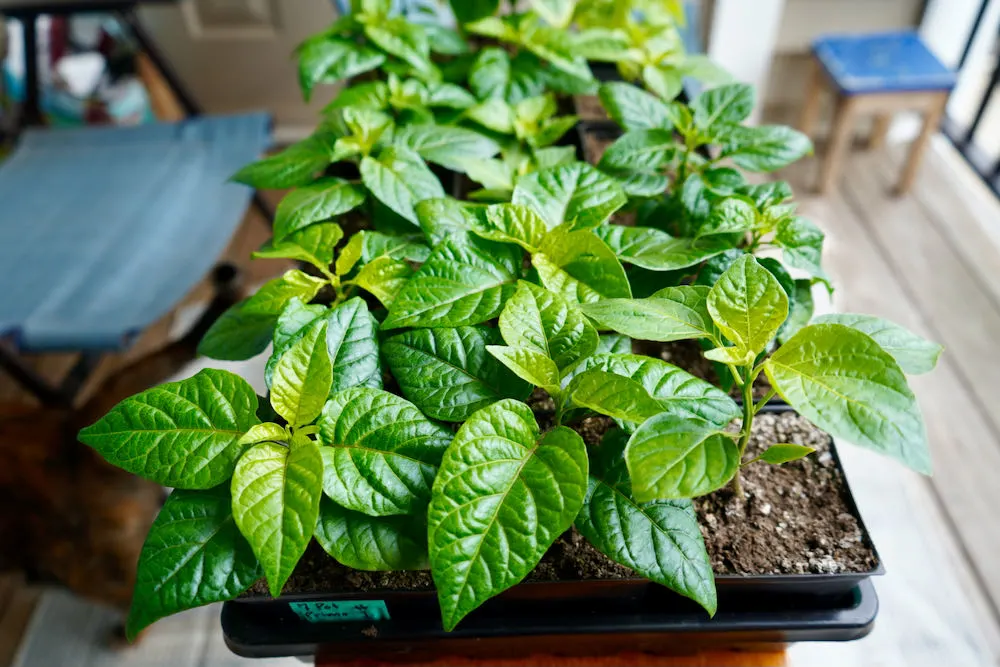
General Pepper Care Tips
Before I get into each individual plant stage, let’s start with some care guidelines that apply throughout the entire lifespan of a pepper plant. Follow these tips during the seedling stage, all the way through to harvesting and beyond.
- Avoid over-watering. Water is essential to all plant life. However, an overabundance of water is a bad thing for pepper plants. This is especially true in potted plants that have little or no drainage. If water is trapped in your pepper pots, it will drown the plant’s roots, leading to root rot and eventual plant death.
- Avoid over-fertilizing. Fertilizing peppers helps achieve large plants and big harvests. Potted pepper plants usually require some form of fertilizer, despite many potting mixes coming with some nutrients. However, too much fertilizer can ‘burn’ your pepper plants. Nutrient burn shows itself as brown spots along the edges of leaves. Excess nitrogen is typically the culprit, so be sure to follow the directions on your store-bought fertilizers and feed them as instructed.
- Use quality soil. If you intend to use bagged potting mix, be sure to choose a high-quality product. We have always had good results with FoxFarm soils (especially Happy Frog). Be sure to do some research and find the best quality soil for your money.
- Provide enough light. Light is key to healthy pepper plants. While they can grow in partial shade, full sun is ideal for the best harvest, flavor, and heat level. In fact, seedlings do best with at least 15 hours of light (which is why a grow light is key early on).
- Change environments gradually. Hardening off is the gradual process of moving plants from indoors to outdoors. This process should be done slowly over a few weeks to avoid shocking the plants. The same is true for many other vegetables as well. Starting on an overcast day, simply acclimate the plants to the outdoors for increasing amounts of time.
We will now narrow down these care tips by plant stage. This will include seedlings, adolescent plants, mature plants, and late-autumn plants.
Pepper Seedling Care Tips
Pepper seedlings are delicate, small, and easy to over-care for. We have learned this the hard way!
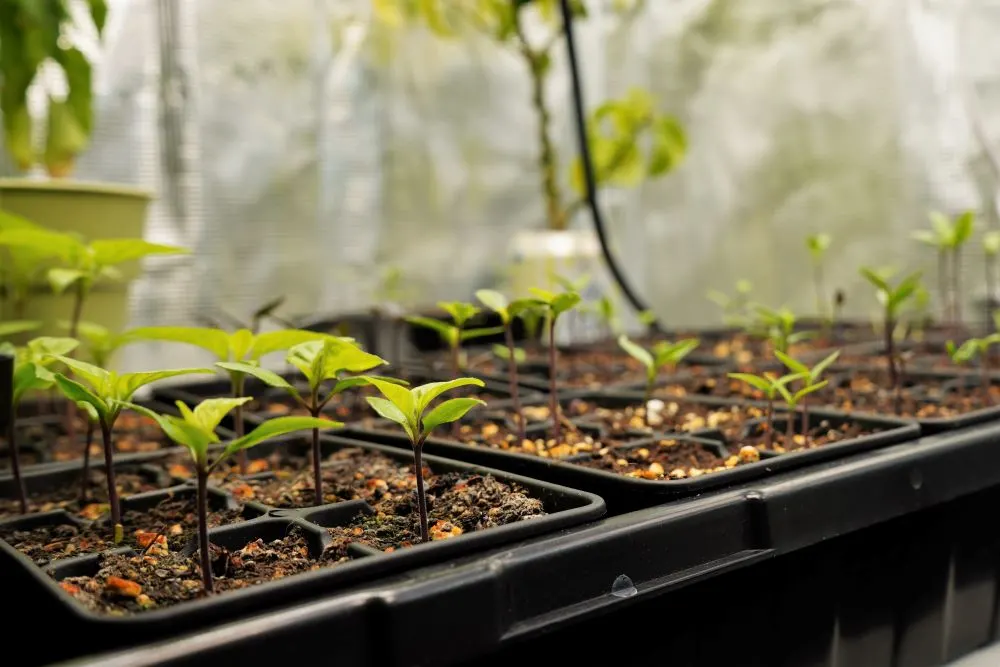
Pepper seedling care tips:
- Bottom water. When pepper plants are a week or two old, they are fragile. Watering from above with a watering can or faucet can damage the stems of the plant. Instead, water from below. Fill your trays with water and allow the soil to soak it up from the bottom. It is important to dump out any excess water from the trays after the plants are adequately watered!
- Provide light immediately. When your pepper seeds sprout, you should immediately provide ample lighting. We use grow lights to give our plants a strong start (15 hours of light per day), but it isn’t required. Ensure your plants are exposed to light on day one.
- Add nutrients (if needed). Seedlings don’t require much nutrition, but they do need a balanced diet to start strong. If you plant seeds in potting soil with added nutrients, there is no need to add additional fertilizer. If your soil does not contain nutrients, begin fertilizing about 1 week after the seeds sprout with a water-soluble fertilizer.
- Transplant to larger pots at the right time. Your peppers can’t live forever in tiny seed cell trays, so transplanting is necessary. The most important part of up-potting is the timing. If you wait too long, your peppers may become root bound, causing them to stop growing and begin producing flowers. Learn how to transplant peppers here.
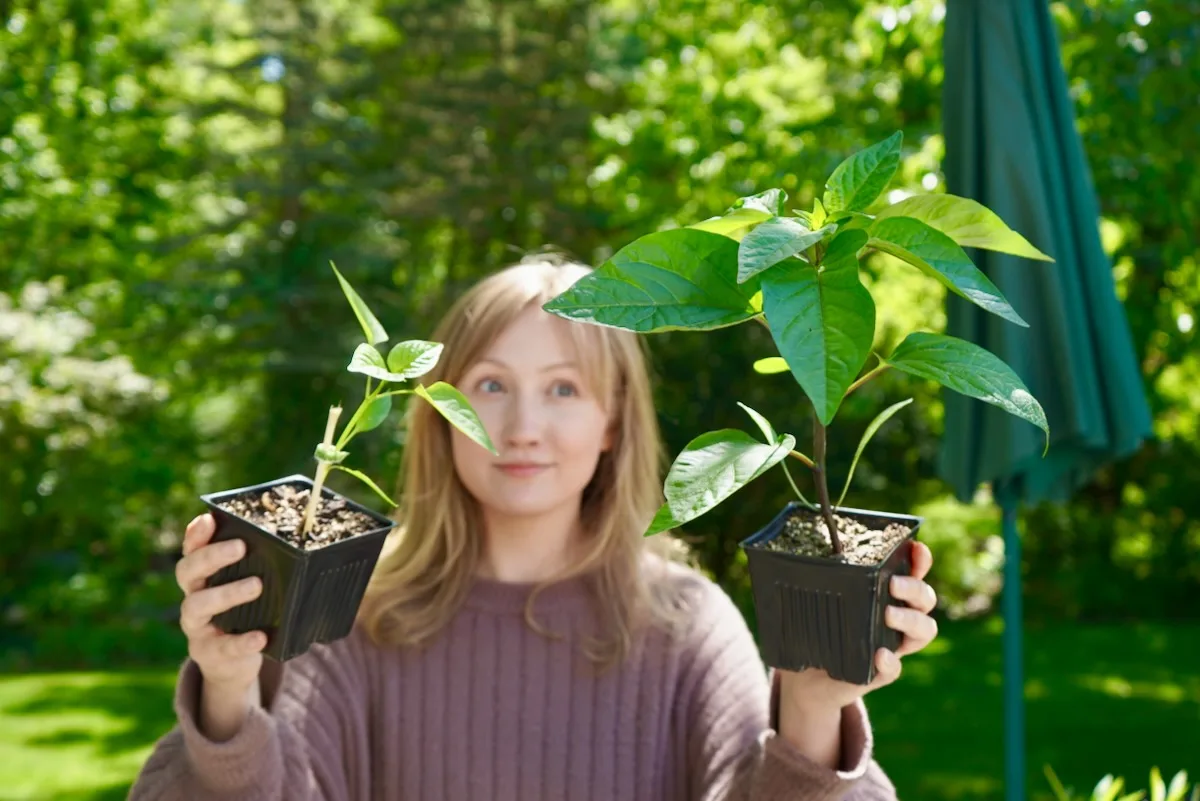
The seedling stage is critical in setting your pepper plants up for success. Without enough light, nutrients or water, the plants can become unhealthy. Don’t over-care for your pepper seedlings, as they don’t need much, just a gentle nudge towards the next growth stage.
Adolescent Pepper Plant Care Tips
After your pepper seedlings are about 2-3 weeks old (after sprouting), they should be ready to move up to a larger pot. We call this stage the ‘adolescent’ stage, and it is basically a period of rapid growth.
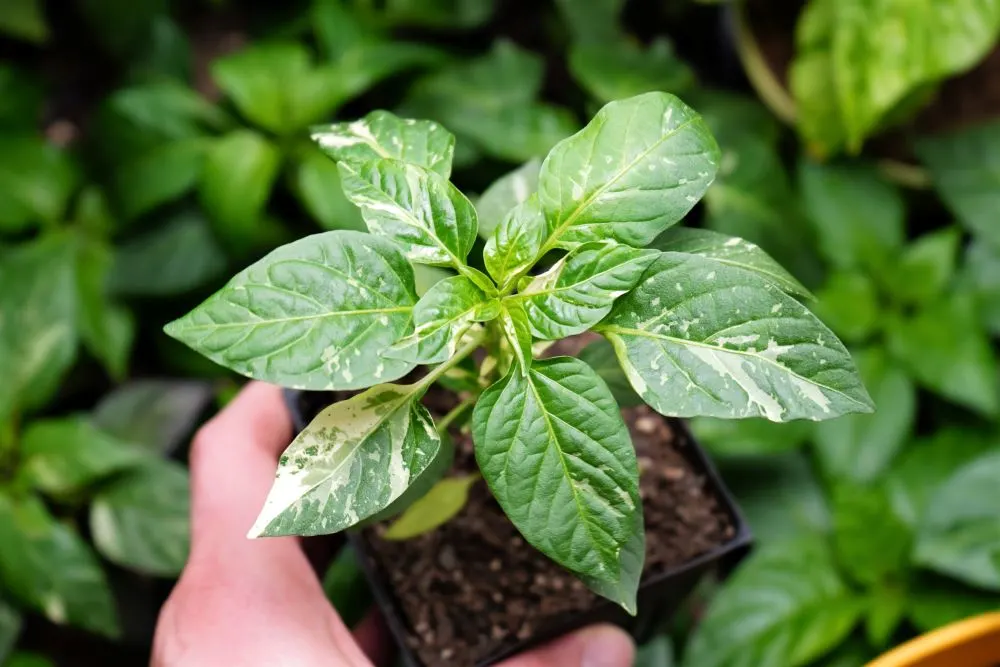
Adolescent pepper plant care tips:
- Use quality potting mix. The soil in which you grow can make or break your results. A bad potting mix can bring your plant growth to a halt. At the adolescent stage, make sure you plant in a proper potting mix. Try to purchase the best quality mix you can (we like FoxFarm soils), or mix your own with basic ingredients.
- Provide a gentle breeze. This tip is helpful when it comes time to move your plants outside. Provide a breeze intermittently throughout the day with an oscillating fan while your plants are still inside. This mimics wind, and helps the plants develop a sturdy stem.
- Fertilize at full-strength. At this stage, pepper plants can handle full-strength fertilizer. However, if your soil contains nutrients, you may be able to skip this step until later in the season when the plants have used up the fertilizer.
- Rotate plants for even lighting. This applies at the seedling stage as well, but it is more likely to be an issue with your plants in larger containers. Larger containers take up more space, meaning that not all of your peppers will be in the ideal position under grow lights. We rotate our trays daily by sliding them down and flipping the trays 180°.
- Harden off properly. Moving outdoors means introducing your pepper plants to the elements (direct sunlight, wind, and precipitation). Begin hardening off on overcast days, then slowly introduce the plants to more direct sunlight until they can handle full-sun. Learn more about hardening off pepper plants here.
- Watch out for rabbits. Rabbits and mice love to nibble on fresh, young pepper plant foliage. This problem subsides as the plants become more established, but young pepper plants should not be left out in the open. Use a fence or keep the plants up on a table to deter these animals.
With ample lighting, pepper plants should grow exponentially faster over time, quickly reaching a mature size in small containers. At this point, I recommend transplanting into a final container or garden bed, and harden off the plants.
Mature Pepper Plant Care Tips
As your plants continue to grow from an adolescent stage to maturity, they will begin producing flowers and continue growing more branches.
Growing inside? See tips for growing pepper indoors year round here.
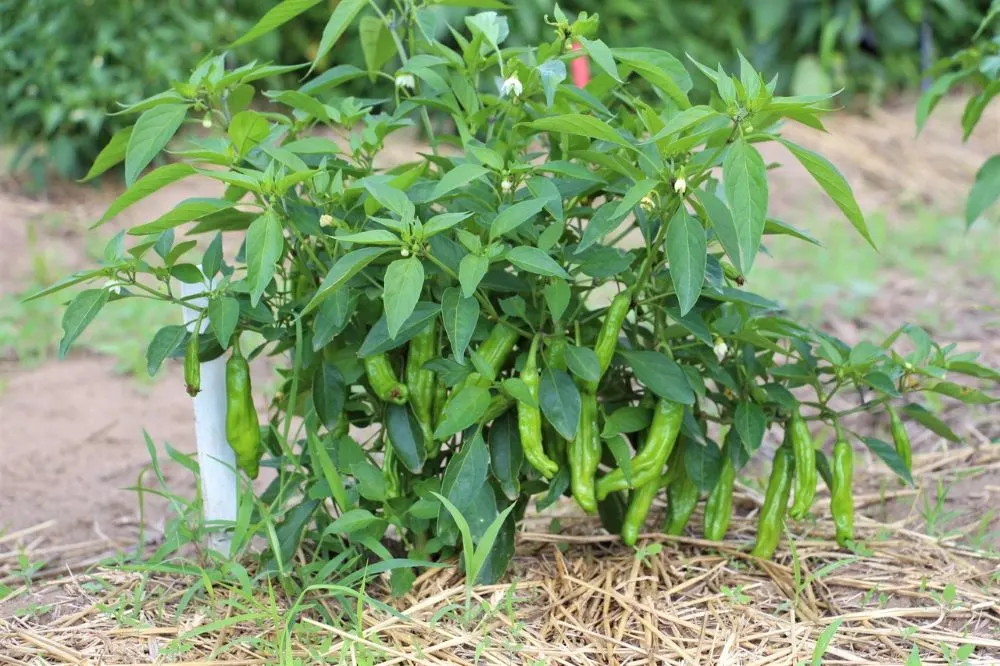
Mature pepper plant care tips:
- Mulch around the base of plants. Providing a buffer between the soil and the underside of your pepper plants is helpful in multiple ways. For one, it keeps the soil from drying out too quickly in the hot sun. It also acts as a barrier, reducing the likelihood of soil-borne pathogens from splashing onto the plants while it rains. We use leaf mulch, straw, or grass clippings as natural mulches.
- Bottom prune low-hanging leaves. Another method of reducing soil splashing is to keep the plant foliage off the soil. Some varieties don’t grow very tall, so this can be tricky. Pluck away lower leaves so that the first leaves are about 6-8″ from the ground.
- Water deeply. After transplanting your peppers outdoors, water deeply and slowly. This ensures the moisture is absorbed deep into the root zone. Then, allow the plant to go unwatered for at least 1-2 weeks to allow the roots to grow deep. If water is running away from your plants, create a small, circular trench around the stem to keep the water at the base of the plants.
- Provide afternoon shade. Even here in New England, the mid-summer heat can be intense. Most pepper varieties can endure hot weather, but they do have a limit. If you are expecting a heatwave, try to provide your plants with some afternoon shade. This is simple with potted plants (just move them into shade), but can be trickier with in-ground plants. One option is to build a structure using a shade cloth. This can help prevent flower drop and improve productivity!
- Attract beneficial insects. Although peppers are self-pollinating, they can always use a hand from local insects. We recommend planting yarrow, tansies, or alyssum nearby your peppers to attract ladybugs and hoverflies, which can help reduce pest populations. See the best pepper plant companions here.
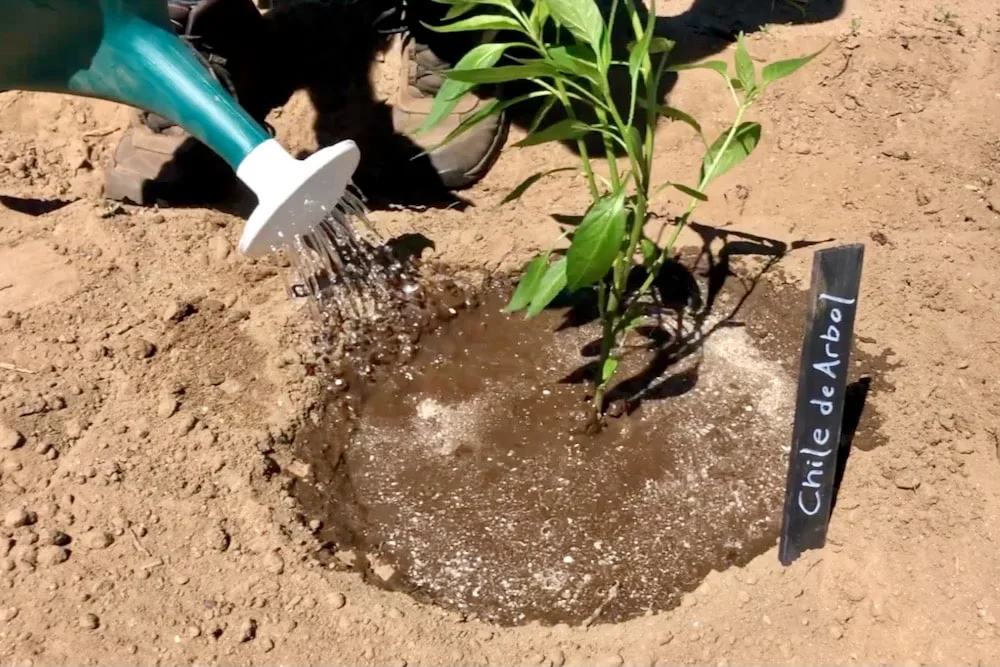
The lifespan of your pepper plants will depend on your local climate. You may have many months of fruitful productivity, or a tight window to harvest your peppers. Either way, there are a few tips as the season draws to a close.
End-of-the-Year Pepper Plant Tips
As the weather begins to cool off, your plants will continue to ripen any existing peppers on the plant. Since peppers originate in a tropical environment, they are actually perennial plants, meaning they will generate fruits until cold weather kills them.
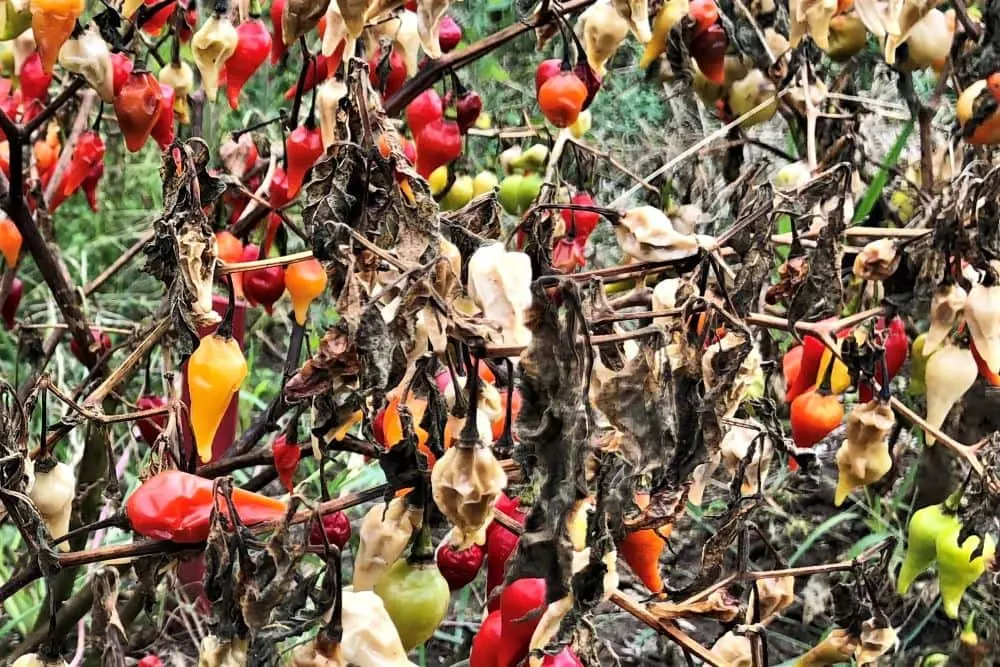
End-of-year pepper plant care tips:
- Harvest any ripe peppers promptly. As your plants produce ripe peppers, I recommend picking them right away. Not only will this give you the best flavor from your peppers, but it will also help trigger the plant to produce more. This is one of many tips for increasing pepper yields.
- Prune newer shoots. Another way to help ripen pods before the winter arrives is to prune away any newer branches on your pepper plants. This will release hormones that direct the plant’s energy elsewhere, resulting in quicker ripening.
- Cover during frost. As winter approaches, you may get the odd overnight frost. If you see a cold night on the forecast, you can help your pepper plants by covering them with a row cover cloth. These are great for both cold weather and hardening off peppers.
- Consider overwintering. Lastly, if you love your pepper plant and don’t want to see it go to the compost bin, consider keeping it alive over the winter. Overwintering peppers involves keeping your pepper plant in a warmer environment (like the garage or basement) through the winter. Then, when the spring comes, the plants will sprout fresh growth and have a head start over plants started from seed!
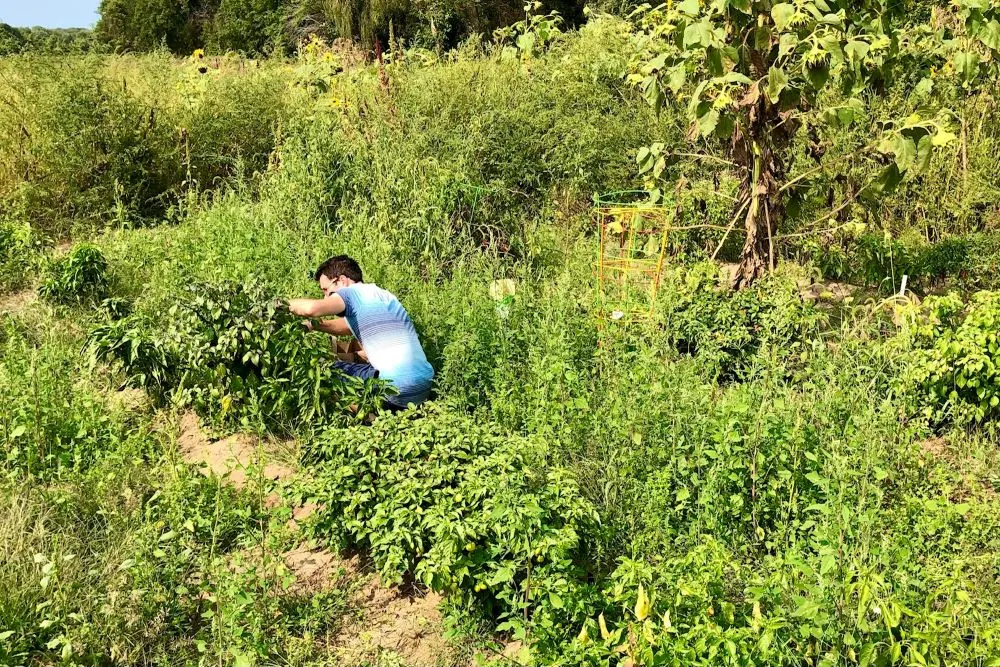
These pepper plant care tips should help you keep your plants looking happy and healthy, all season long. However, there are a variety of pepper plant problems that can arise during the year. Keep an eye out for any issues, such as aphids and other insect pests, diseases, and rabbits!
Read Next:
I hope this article was useful and allows you to have a successful pepper garden. Let us know anything you do to better care for your pepper plants in the comments below!


Henry J
Wednesday 10th of April 2024
Always great info and look forward to the email newsletters. Thanku very much. Maybe a shirt with your logo available sometime? I am a pepper geek and would like to show the pride. Cheers.
peppergeek
Thursday 18th of April 2024
Thanks so much Henry. We have an Etsy shop with shirts available here: https://www.etsy.com/shop/PepperGeek
Mary
Wednesday 10th of April 2024
Well, started plants too early!! UGGH! They have started to get buds on them. I also have edema on several!! I have a couple hundred plants seedlings. Am I doomed with the edema? I have fan on them, separated some, rotate them. We grow for two different markets-attend 3 times a week. Thank You for the tips!!
peppergeek
Friday 19th of April 2024
Edema isn't a huge deal - it looks bad, but has always cleared up for us after moving outside. As soon as you can start hardening off, get them outside! They love the fresh air
donald
Wednesday 10th of April 2024
you’re doing it right i been growing peppers 45 years
Amanda
Sunday 24th of September 2023
Fantastic advice, a school Day for me of the best pepper kind. I have pepper plants in conservatory several fruits and more flowers coming. Going to prune bk slightly to aid harvesting time. Thanks for all your expertise.
Michael P
Thursday 14th of September 2023
I have a Poblano plant with about 8 pepper growing at the moment. Several of them have started turning brown and mushy at the tips. What could cause that? And is there anything I can do about it?